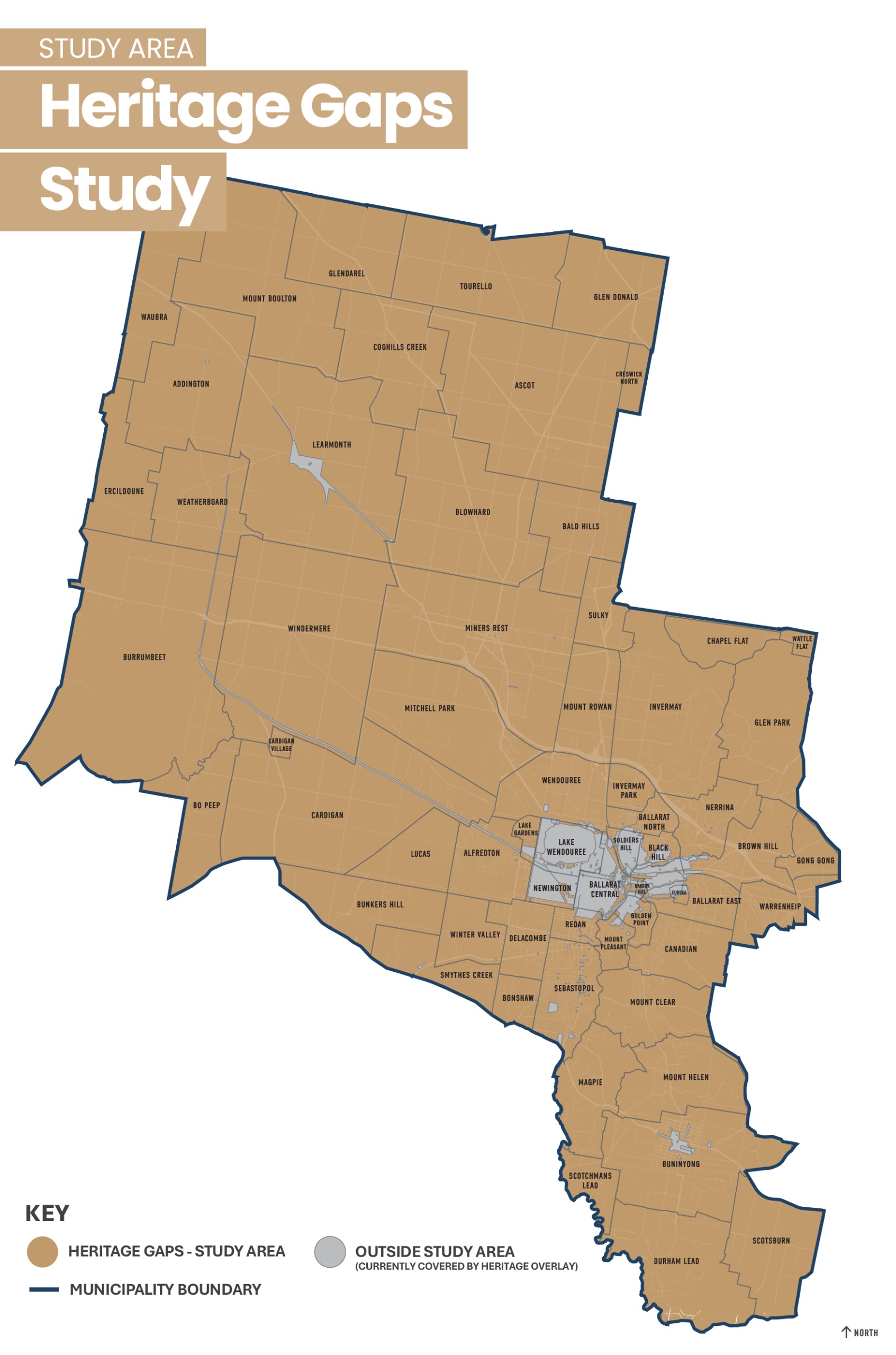What is the Heritage Gaps Study?
The Heritage Gaps Study is about finding important places in Ballarat that may have been overlooked in previous heritage assessments. Our goal is to ensure that all places of heritage significance are properly identified, valued, and considered for protection. This project is part of our broader Heritage Gaps Review Program.
The Gaps Study has two stages; The first stage focusses on finding places of heritage significance that should be further assessed. The second stage will undertake the heritage assessments and work out what should be included in the Heritage Overlay.
This study is currently in the planning phase and will officially commence once a heritage consultant is appointed. You can still get involved – nominations are now open for heritage places you believe should be protected. See below for how to submit yours.
Ballarat’s heritage is a key part of what makes our municipality special, but not all significant places have been formally identified or protected. This study is being undertaken to find these places and ensure our city’s heritage is protected now and into the future.
By identifying and addressing heritage gaps, the study helps protect the unique character and heritage of our city - now and into the future. It aims to safeguard Ballarat's heritage assets by identifying important places that may not yet be protected under the Ballarat Planning Scheme.
Incorporating these places into the Planning Scheme ensures that as Ballarat continues to grow and evolve, its heritage is properly recognised and considered in planning decisions.
This helps future generations understand, enjoy and connect with Ballarat’s rich heritage.
We’re reviewing Ballarat’s history, gathering local knowledge, and identifying places that may have heritage value. This includes research, windscreen surveys, community engagement, site visits, and looking at community nominations to help build a more complete picture of our city’s heritage. In the later part of the study we will be undertaking in depth heritage assessments using our City of Ballarat Heritage Study and Assessment Model Methodology.
Nominate a Heritage Place
Know a place with local heritage value? Tell us! Nominations for places that you think should be considered for heritage protection are now open!

FAQs
The Heritage Gaps Study is about identifying places in Ballarat that may have been missed in past heritage work. In Stage 1, we’re looking at different types of places to see if they might be locally significant.
In Stage 2, we’ll take a closer look at those with strong potential to confirm their heritage value.
If a place is found to be significant, it may be recommended for heritage protection, which can include:
- Local protection through the Heritage Overlay in the planning scheme.
- State-level protection via the Victorian Heritage Register.
These protections help ensure Ballarat’s important places are conserved now and in the future.
The review includes:
- New places or areas that may meet the criteria for heritage significance and should be added to the Heritage Overlay
- Heritage gradings, statements of significance, and relevant planning controls
The Heritage Overlay is part of the Ballarat Planning Scheme. It helps protect places of historical, cultural, or architectural significance. It ensures any changes to those places are carefully considered through the planning process.
A Heritage Assessment is a process used to determine the cultural, historical and social significance of a place or object.
The significance of places is evaluated based on established criteria as per Planning Practice Note 1 (Applying the Heritage Overlay), including:
- Historical
- Aesthetic
- Representative
- Rarity
- Research potential
- Technical
- Associative
- Architectural
- Social value of a site
Heritage assessments are usually done by independent heritage experts and play an important role in identifying and documenting places of value. They help decide if a place should be included in the Heritage Overlay, which means it needs to be considered in planning decisions.
If you own or live near a heritage place or precinct, there may be updates to how it is listed or described in the planning scheme. No changes have been made yet, and there is no immediate impact to planning controls at this stage.
Once the study is complete, recommendations will be considered by Council. If changes to the planning scheme are proposed, they will go through a formal Planning Scheme Amendment process, including a public consultation where you will have the chance to put a submission in support of the assessment or object to the assessment. All submissions need to be resolved before a change is made to the Planning Scheme.
Definitions
- Place: A site, building, structure, or landscape or other element with cultural heritage value.
- Precinct: A group of heritage places that together have heritage significance.
- Curtilage: The defined area of land around a heritage place or precinct that the Heritage Overlay is applied to.
- Heritage Criteria: The criteria used for the assessment of the heritage value of a place ( historical significance, rarity, aesthetic significance, research potential, technical significance, social significance, representative significance, associative significance).
- Citation: A document that explains why a place is considered to have heritage value, including its history and description. The citation also includes a comparative analysis that evaluates a place's significance against other similar places to determine its relative importance.
- Statement of Significance: A summary that explains why a place or precinct is important and what aspects are significant and how these aspects meet the criteria.
- Individually Significant: A place that is important on its own
- Contributory: A place that adds to the heritage value of a precinct but is not individually significant.
- Non-contributory: A place within a heritage precinct that does not have heritage value itself.
- Heritage Controls: Planning tools that protect heritage places by managing alteration, additions, demolitions, and new developments.
- Group, thematic and serial (GTS) listings may be used for two or more places that share heritage significance but are geographically separate so do not form a geographically cohesive heritage precinct.





